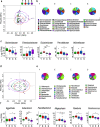The Human Gut Resistome up to Extreme Longevity
- PMID: 34494880
- PMCID: PMC8550338
- DOI: 10.1128/mSphere.00691-21
The Human Gut Resistome up to Extreme Longevity
Abstract
Antibiotic resistance (AR) is indisputably a major health threat which has drawn much attention in recent years. In particular, the gut microbiome has been shown to act as a pool of AR genes, potentially available to be transferred to opportunistic pathogens. Herein, we investigated for the first time changes in the human gut resistome during aging, up to extreme longevity, by analyzing shotgun metagenomics data of fecal samples from a geographically defined cohort of 62 urban individuals, stratified into four age groups: young adults, elderly, centenarians, and semisupercentenarians, i.e., individuals aged up to 109 years. According to our findings, some AR genes are similarly represented in all subjects regardless of age, potentially forming part of the core resistome. Interestingly, aging was found to be associated with a higher burden of some AR genes, including especially proteobacterial genes encoding multidrug efflux pumps. Our results warn of possible health implications and pave the way for further investigations aimed at containing AR accumulation, with the ultimate goal of promoting healthy aging. IMPORTANCE Antibiotic resistance is widespread among different ecosystems, and in humans it plays a key role in shaping the composition of the gut microbiota, enhancing the ecological fitness of certain bacterial populations when exposed to antibiotics. A considerable component of the definition of healthy aging and longevity is associated with the structure of the gut microbiota, and, in this regard, the presence of antibiotic-resistant bacteria is critical to many pathologies that come about with aging. However, the structure of the resistome has not yet been sufficiently elucidated. Here, we show distinct antibiotic resistance assets and specific microbial consortia characterizing the human gut resistome through aging.
Keywords: aging; antibiotic resistance; extreme longevity; metagenome; microbiome; resistome.
Figures




Similar articles
-
Probiotics impact the antibiotic resistance gene reservoir along the human GI tract in a person-specific and antibiotic-dependent manner.Nat Microbiol. 2021 Aug;6(8):1043-1054. doi: 10.1038/s41564-021-00920-0. Epub 2021 Jul 5. Nat Microbiol. 2021. PMID: 34226711 Free PMC article.
-
Comparative gut microbiota and resistome profiling of intensive care patients receiving selective digestive tract decontamination and healthy subjects.Microbiome. 2017 Aug 14;5(1):88. doi: 10.1186/s40168-017-0309-z. Microbiome. 2017. PMID: 28803549 Free PMC article.
-
Antibiotic resistomes of healthy pig faecal metagenomes.Microb Genom. 2019 May;5(5):e000272. doi: 10.1099/mgen.0.000272. Epub 2019 May 15. Microb Genom. 2019. PMID: 31091181 Free PMC article.
-
Systematic review of human gut resistome studies revealed variable definitions and approaches.Gut Microbes. 2020 Nov 9;12(1):1700755. doi: 10.1080/19490976.2019.1700755. Epub 2020 Jan 16. Gut Microbes. 2020. PMID: 31942825 Free PMC article.
-
The human gut resistome.Philos Trans R Soc Lond B Biol Sci. 2015 Jun 5;370(1670):20140087. doi: 10.1098/rstb.2014.0087. Philos Trans R Soc Lond B Biol Sci. 2015. PMID: 25918444 Free PMC article. Review.
Cited by
-
Resistome in the indoor dust samples from workplaces and households: a pilot study.Front Cell Infect Microbiol. 2024 Dec 3;14:1484100. doi: 10.3389/fcimb.2024.1484100. eCollection 2024. Front Cell Infect Microbiol. 2024. PMID: 39691696 Free PMC article.
-
Importance of Microbiome of Fecal Samples Obtained from Adolescents with Different Weight Conditions on Resistance Gene Transfer.Microorganisms. 2022 Oct 9;10(10):1995. doi: 10.3390/microorganisms10101995. Microorganisms. 2022. PMID: 36296271 Free PMC article.
-
Resistome expansion in disease-associated human gut microbiomes.Microbiome. 2023 Jul 29;11(1):166. doi: 10.1186/s40168-023-01610-1. Microbiome. 2023. PMID: 37507809 Free PMC article.
-
Next steps after 15 stimulating years of human gut microbiome research.Microb Biotechnol. 2022 Jan;15(1):164-175. doi: 10.1111/1751-7915.13970. Epub 2021 Nov 24. Microb Biotechnol. 2022. PMID: 34818454 Free PMC article.
-
Longevity-Associated Core Gut Microbiota Mining and Effect of Mediated Probiotic Combinations on Aging Mice: Case Study of a Long-Lived Population in Guangxi, China.Nutrients. 2023 Mar 26;15(7):1609. doi: 10.3390/nu15071609. Nutrients. 2023. PMID: 37049450 Free PMC article.
References
-
- Cassini A, Högberg LD, Plachouras D, Quattrocchi A, Hoxha A, Simonsen GS, Colomb-Cotinat M, Kretzschmar ME, Devleesschauwer B, Cecchini M, Ouakrim DA, Oliveira TC, Struelens MJ, Suetens C, Monnet DL, Strauss R, Mertens K, Struyf T, Catry B, Latour K, Ivanov IN, Dobreva EG, Tambic Andraševic A, Soprek S, Budimir A, Paphitou N, Žemlicková H, Schytte Olsen S, Wolff Sönksen U, Märtin P, Ivanova M, Lyytikäinen O, Jalava J, Coignard B, Eckmanns T, Abu Sin M, Haller S, Daikos GL, Gikas A, Tsiodras S, Kontopidou F, Tóth Á, Hajdu Á, Guólaugsson Ó, Kristinsson KG, Murchan S, Burns K, Pezzotti P, Gagliotti C, Dumpis U, et al. . 2019. Attributable deaths and disability-adjusted life-years caused by infections with antibiotic-resistant bacteria in the EU and the European Economic Area in 2015: a population-level modelling analysis. Lancet Infect Dis 19:56–66. doi:10.1016/S1473-3099(18)30605-4. - DOI - PMC - PubMed
-
- OECD. 2018. Stemming the superbug tide: just a few dollars more. OECD Health Policy Studies. OECD, Paris, France. doi:10.1787/9789264307599-en. - DOI
-
- World Health Organization. 2014. Antimicrobial resistance: global report on surveillance 2014. WHO, Geneva, Switzerland. https://apps.who.int/iris/handle/10665/112642.
-
- Hendriksen RS, Munk P, Njage P, van Bunnik B, McNally L, Lukjancenko O, Röder T, Nieuwenhuijse D, Pedersen SK, Kjeldgaard J, Kaas RS, Clausen PTLC, Vogt JK, Leekitcharoenphon P, van de Schans MGM, Zuidema T, de Roda Husman AM, Rasmussen S, Petersen B, Amid C, Cochrane G, Sicheritz-Ponten T, Schmitt H, Alvarez JRM, Aidara-Kane A, Pamp SJ, Lund O, Hald T, Woolhouse M, Koopmans MP, Vigre H, Petersen TN, Aarestrup FM, Global Sewage Surveillance project consortium . 2019. Global monitoring of antimicrobial resis- tance based on metagenomics analyses of urban sewage. Nat Commun 10:1124. doi:10.1038/s41467-019-08853-3. - DOI - PMC - PubMed
MeSH terms
Substances
LinkOut - more resources
Full Text Sources
Medical
Research Materials
